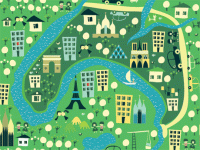5 Ways Literature Can Teach Global Lessons in Elementary Classes
Children's books with multicultural settings and characters can transport us on a global adventure, dispelling negative stereotypes, teaching tolerance and respect, encouraging pride in kids' cultural heritage, and showcasing universal human emotions and feelings. When paired with extension activities, quality multicultural literature teaches kids about the world beyond our communities while sharpening their critical thinking skills.
Here are five concrete ways that teachers can use literature to get their kids excited about reading as they learn about the world.
1. See How Far Books Can Take You
Combine geography and ELA in a classroom display. Hang up a world map, and map the settings of the books that you read as a class during the year. Purposefully choose books that represent many geographic areas, and include both fiction and nonfiction. This graphic wall organizer will help you recognize regions of the world that have been overlooked.
2. Join a Worldwide Book Club
Join the Global Read Aloud and connect with students in New Zealand, India, and the U.K. in a virtual book discussion. Using Twitter, Skype, Edmodo, Kidblog, and other #edtech tools to make connections during a six-week period, classes from kindergarten through high school participate in this growing collaborative project.
3. Compare Fairy Tales Across Cultures
Finding similarities and differences when reading fairy tales, folklore and fables from around the world encourages kids to focus on the details and hone their critical thinking skills. The Common Core includes this "Reading Literature" standard (RL.2.9):
Other examples that kids enjoy are The Gingerbread Man and Trickster Tales, whose clever and silly antics appear in many cultures around the world. Though the storylines are diverse, characters have a common need for hope, security, and love from family and friends. Stories also show universal feelings of happiness, anger and pride. When reading the diverse fairy tales, notice how the cultures portray and deal with these emotions, and compare them to how the students, their family and their friends would show the same feelings.
4. Teach Tolerance, Empathy and Respect
It is crucial that we expose our students to those who come from a different background, with diverse struggles and triumphs, who have distinct experiences. After reading such stories and understanding the backstories more fully, children will more likely sympathize with others. Stories about kids from other cultures -- or immigrants -- increase cultural awareness and demonstrate the need to show respect and compassion.
In addition to fictional stories, teachers can read biographies of leaders from around the world who embody peace, and discuss the challenges they have overcome. International leaders such as the Dalai Lama, Wangari Maathai, Jane Goodall or Nelson Mandela provide examples of character traits and inspiring lessons.
Questions to ask your students:
- Why is he or she admired around the world?
- What characteristics and values does this person have that makes him or her a good leader?
- Think about the challenges he or she overcame. What would be the hardest part for you under those circumstances?
- If you could meet this person, what would you like to ask him or her?
5. Dispel Stereotypes and Get Facts from the Source
Explore "A Day in the Life"-type books with your students that show typical kids doing typical activities in other countries. Books like Florence Parry Heide's Day of Ahmed's Secret, Stacy Bellward's Ethiopian Voices: Tsion's Life or Maria de Fatima Campos' Cassio's Day: From Dawn to Dusk in a Brazilian Village follow children through a typical day from when they wake up until they go to sleep. After reading several stories, chart the similarities and differences between these children's lives and your students' lives. Talk about what kids eat, what they play with, where they live, who is in their family, how they get to school, how they learn, and more. Open your students' minds to distinct perspectives and ways of going through the day.
What multicultural resources do you use in your K-5 classroom? How do you bring them to life?
